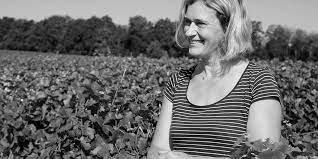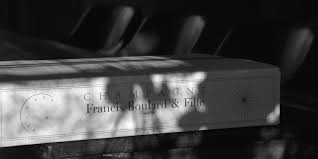In 2009, Raymond Boulard’s three children decided to follow their own professional paths. The Raymond Boulard Champagne House ceased to exist therefore. Francis Boulard, his wife Jeanne and daughter Delphine started the house called Champagne Francis Boulard & Fille.

For many years, Francis Boulard pushed the Raymond Boulard family estate towards organic methods; hence it is that some of their parcels were already converted and certified to be organic. With his daughter Delphine, he can now take this movement towards the most natural champagne wines possible to its logical conclusion. Their goal is to see the whole estate certified organic.
Francis Boulard and his daughter Delphine belong to a family of winegrowing winemakers for 6 generations… doubtless more. The oldest member of the family who could be traced was born during the French Revolution in 1792.
Francis Boulard’s first contact with wines came about thanks to his grandfather, Julian: at 14, the young Francis was given permission to hold the handles of the plough behind Bijou the horse, a sturdy Ardennes horse. His grandfather was in fact one of the last to resist the galloping mechanisation which followed the end of WW II, still using a horse to plough his 2 hectares (5 acres) of vines.

Julien Boulard sold his still wines to champagne houses. It was his son, Raymond Boulard who decided to vinify and bottle champagne in 1952. In the 70s, the young Francis joined the company Boulard Frères and very soon afterwards (1975) was made responsible for vinification.
The champagne house Raymond Boulard & Fils was founded in 1980. After the death of their father, his three children continued running the family estate together. Francis Boulard, while still continuing with the vinification, became ever increasingly interested in viticulture. Wanting to move towards vines that were grown as naturally as possible, he pushed the estate towards organic methods, resulting in the conversion in the 2000s of a proportion of the vineyards towards organic agriculture.
Les Rachais Rose Extra Brut NV
Les Rachais Rosé pink champagne comes from two plots of Pinot Noir cultivated using biodynamic principles and following the lunar calendar. Absolutely no weedkillers or synthetic chemicals are used (controled by Ecocert as from 2004). This wine is made as per the “Rosé de saignée” method.
| Wine: | Les Rachais Rosé |
| Appellation : | Champagne Extra Brut |
| Terroir: | Plot “Hurtebise/Les Rachais” in the Massif de Saint Thierry. Sandy limestone soils. Average age of the vines: 25 years |
| Composition: | 100% Pinot Noir |
| Dosage: | 2 g/L |
| Certification: | ECOCERT (conversion control) |
| Bottle sizes: | 75 cl bottle |
Vinification :
10-12 hours maceration is given before pressing. Spontaneous fermentation with indigenous yeasts. Vinified on fine lees in old small oak barrels with “batonnage” (beating in) on “Fruit” and “Flower” days. Malo-lactic fermentation takes place. Bottled on “fruit days” of the lunar calendar. Unfined and unfiltered.
Les Rachais Extra Brut NV
Les Rachais champagne comes from a single plot cultivated using biodynamic principles and following the lunar calendar. Made from 100% Chardonnay grapes, it is a champagne with an attractive personality, allying power and grace.
| Wine: | Les Rachais | |
| Appellation : | Champagne Brut Nature | |
| Terroir: | Plot “Hurtebise/Les Rachais” in the Massif de Saint Thierry. Sandy limestone soils. Average age of the vines: 43 years | |
| Composition: | 100% Chardonnay – Massale selection | |
| Dosage: | 0 g/L | |
| Certification: | ECOCERT – Organic | |
| Bottle sizes: | 75 cl bottle | |
Vinification :
Spontaneous alcoholic fermentation with indigenous yeasts. Vinified on fine lees in old small oak barrels with “batonnage” (beating in) on “Fruit” and “Flower” days. Malo-lactic fermentation takes place. Bottled on “fruit days” of the lunar calendar. Unfined and unfiltered.
Tasting notes
Rich nose of fully ripe white fruit, citrus, pastries and of dried fruit with a slight hint of honey. In the mouth, the wine is mouth filling, with a fine texture. Powerful and long.
Suggestions
Serve at 10 °C (50°F) as an aperitif, or at table with fish, poultry and white meats. The wine shows at its best after several minutes of aeration.
Blanc de Blanc Vieilles Vignes Extra Brut
Vieilles Vignes is a “blanc de blancs” organic champagne. It is made entirely from Chardonnay grapes which give it finesse and freshness. It is available in Extra-Brut and Brut Nature versions.
| Wine: | Vieilles Vignes | |
| Appellation : | Champagne Extra-Brut or Brut Nature | |
| Terroir: | Plot called “Le Murtet” – Sandy limestone terroir on the Massif de Saint-Thierry | |
| Composition : | 100% Chardonnay, blanc de blancs | |
| Dosage: | Extra-Brut : 3 to 5 g/L Brut Nature : 0 g/L | |
| Certification: | Bio ECOCERT << FR BIO-01 >> (Organic) | |
| Bottle size: | 75 cl bottle | |
Vinification of the Champagne
Spontaneous fermentation with indigenous yeasts. Vinification on fine lees in small barrels and large casks with batonnage (beating in). Malo-lactic fermentation takes place. Wine aging in oak barrels. Unfined. Bottled on “Fruit days”.
Tasting notes
Nose of white flowers and citrus. The champagne is supple, fine and round in the mouth, well supported by good freshness and a touch of minerality.
The vines of the Francis Boulard & Fille estate are mainly to be found in Cormicy, to the north-west of Reims in the Saint-Thierry hills nicknamed “la Petite Montagne de Reims“.
The estate’s vines are also to be found in Paradis (the Belval hamlet in the Marne valley), in Cuchery, in Cauroy-les-Hermonville and in Mailly-Champagne, a village of the “Montagne de Reims” classified as Grand Cru 100%. The vines mainly face east-north-east, and south in the Marne valley.
The estate’s orientation towards organic cultivation goes back several years. Wanting to make Champagne wines of character and as natural as possible, a goodly proportion of the vines in Cormicy have been cultivated without weedkillers or synthetic chemicals since 2001. This conversion has been controlled by Ecocert since 2004. Since then, they have been cultivated biodynamically (see below) and certified by Ecocert. Now that the Francis Boulard & Fille Estate is well established, the objective, naturally enough, is to see 100% of the estate certified as cultivated organically and the conversion of those which are not yet certified was immediately set in motion
Biodynamics allows a greater complexity of the wines to be achieved, and encourages an attractive minerality to appear in Champagne wines. It goes without saying that biodynamics (like organic cultivation) allows all the negative effects of the use of synthetic chemicals on the environment and health to be avoided.
The lunar calendar illuminates the best moment to work on the vines For Francis Boulard, it reminds him of his grandfather who often spoke to him of the influence of the moon on planting or on working the soil. In the time of his grandfather and great-grandfather, cultivation was thus closer to nature and the rhythm of the seasons.
The vines are pruned short, in order to control yield, thereby producing better grapes. Green harvesting (removing unwanted bunches produced over the summer) is therefore rarely carried out. The majority of the vineyards, about two thirds, are planted using “massal selection”(1).
The vineyards are ploughed 4 to 6 times a year, in the autumn after the harvest, in the spring and on up to July. These light ploughings facilitate the control of their natural weed cover.
This natural weed cover encourages the soil to live and avoids erosion. To fight against fungal attacks, the vines are protected, in addition to the use of sulphur and Bordeaux mixture, by the use of biodynamic preparations based on field horsetail, water willow or osier, willow, nettles, valerian and silica
Some figures:
– Total surface: 3 Ha (7.5 acres)
– Varietals used:
30% Chardonnay, 30% Pinot Noir, 40% Pinot Meunier
– Average age of the vines: 35 years
– Rootstock:
SO4 for Chardonnay, 41 B and 3309 for the Pinots.
– Location: Massif de Saint-Thierry, Marne Valley
and Montagne de Reims (Mailly-Champagne Grand Cru)
Massal Selection: Using shoots from the best plants in the plot to provide scions to plant in new plots, and replace sick or missing plants. This technique allows the quality of a vineyard to be improved, while conserving its individuality and its character.


